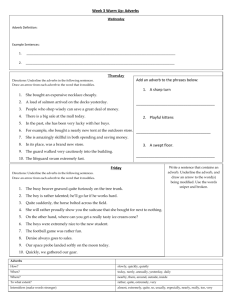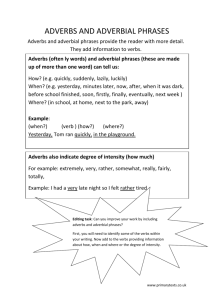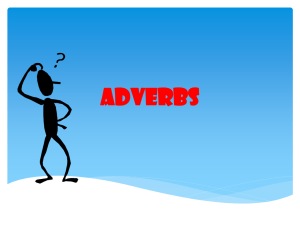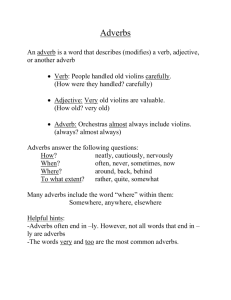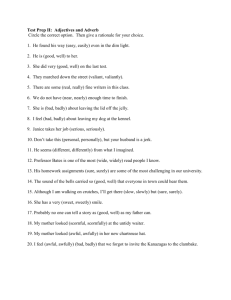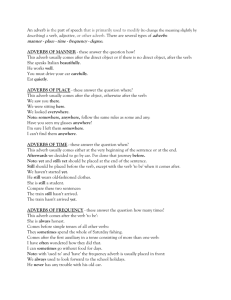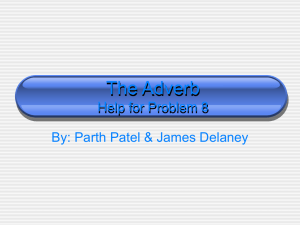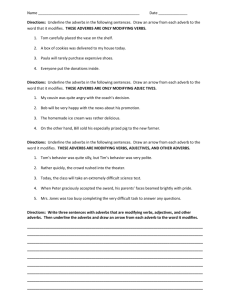really too very much - University of Birmingham
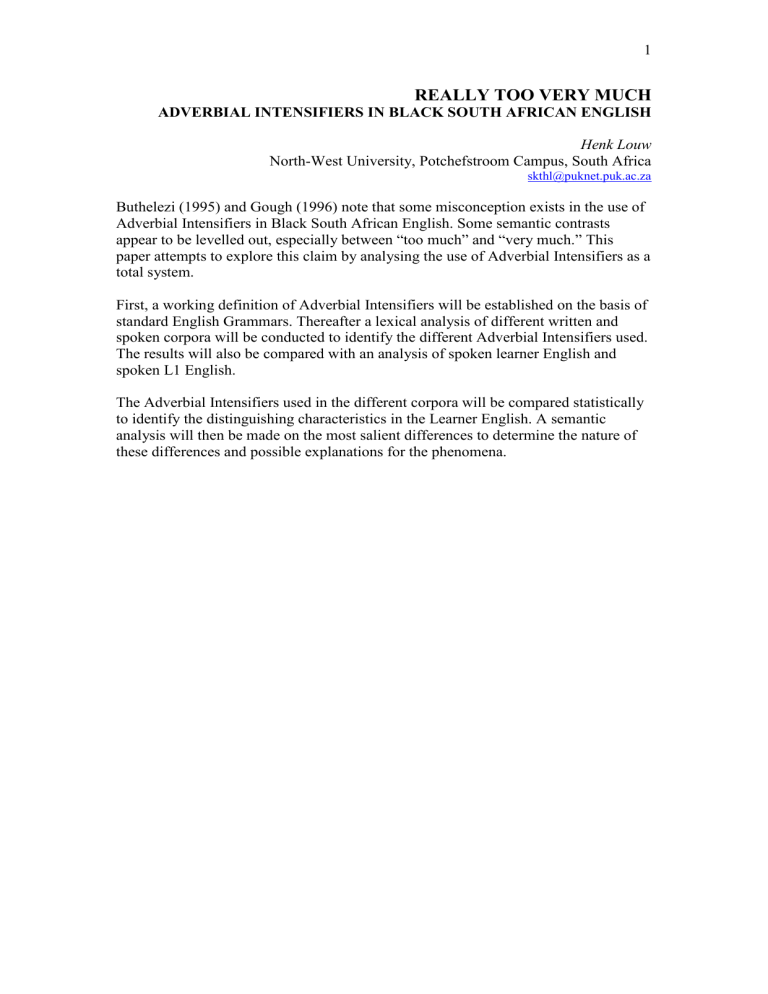
1
REALLY TOO VERY MUCH
ADVERBIAL INTENSIFIERS IN BLACK SOUTH AFRICAN ENGLISH
Henk Louw
North-West University, Potchefstroom Campus, South Africa skthl@puknet.puk.ac.za
Buthelezi (1995) and Gough (1996) note that some misconception exists in the use of
Adverbial Intensifiers in Black South African English. Some semantic contrasts appear to be levelled out, especially between “too much” and “very much.” This paper attempts to explore this claim by analysing the use of Adverbial Intensifiers as a total system.
First, a working definition of Adverbial Intensifiers will be established on the basis of standard English Grammars. Thereafter a lexical analysis of different written and spoken corpora will be conducted to identify the different Adverbial Intensifiers used.
The results will also be compared with an analysis of spoken learner English and spoken L1 English.
The Adverbial Intensifiers used in the different corpora will be compared statistically to identify the distinguishing characteristics in the Learner English. A semantic analysis will then be made on the most salient differences to determine the nature of these differences and possible explanations for the phenomena.
2
1. WORKING DEFINITION OF ADVERBIAL INTENSIFIERS
The definitions for parts of speech are not in all cases the same. For instance, one can argue that Intensifier is a subcategory of Degree Adverbs, since some (most) Degree
Adverbs are not necessarily intensifying . One can also argue that an Intensifying
Adverb is a different category altogether. In this paper, I will not make either of these distinctions, but use Degree Adverb and Intensifying Adverb interchangeably. The main reason for this is that there seems to be no distinction between Degree Adverb and Intensifying Adverb in academic literature or in corpus linguistic practice. For example, the International Corpus of English (ICE) uses the part-of-speech tag,
“Adverb, Intensifier” to mean both. Compare the following extracts from ICE:
1.
“... for the relatively simple way in which entries could be added....”
2.
“I chose this approach almost immediately.”
3.
“... but is complicated severely by the need to update the first....”
All three examples were tagged as intensifying adverb. It should be obvious that examples 1 and 2 are in fact downtoning the intensity, while example 3 is doing the
“real” job of intensifying. It is clear that ICE seems to use the term Intensifying
Adverb to mean the same as Degree Adverb . To substantiate the claim that it is simply the intensity that is referred to in Intensifying Adverb , compare the Quirkian intensifier categories mentioned by Lorenz (1998:56). It is a set of scalar intensifier categories defined according to the respective degree they express.
CATEGORY TYPICAL WORDS EXPLANATION
Maximizers
Boosters completely, absolutely, etc very, highly, immensely, etc
Cannot get more than this.
TYPICAL EXAMPLES
FROM DATA
Now I’m going to ask you something completely different…
Julie is very nice.
Approximators
Compromisers
Diminishers
Minimizers nearly, virtually, etc fairly, pretty, rather, etc slightly, a little, etc.
hardly, scarcely
Very intense, but there is the possibility of it getting even more intense.
Showing “almost but not quite.”
Indicating that a statement is near to correct, but not 100% so.
Allowing opportunity for someone else to disagree with the statement.
Showing the statement is true to a small degree.
Showing the statement is not true or true to a very small degree.
…even though in practice it would be virtually impossible.
But she was pretty insistent…
…in fact, it's probably slightly stronger tasting…
These countries can hardly afford to take care of…
TABLE 1: CATEGORIES OF ADVERB TYPES
Maximizers and Boosters are truly intensifying, while Approximators, Compromisers,
Diminishers and Minimizers are downtoners. One can almost place these on a spectrum with Maximizers on one end and Minimizers on the other. There are no
“neutral” adverbs showing intensity.
Pullum and Huddleston’s
The Cambridge Grammar of the English Language (2002) also does not make the distinction between Degree Adverbs and Intensifying Adverbs, so the distinction seems to be of lesser importance in academic writing.
3
But what is a Degree Adverb then? A Degree Adverb can modify a:
4.
Quantifying Pronoun: “There are too many spelling mistakes in that essay.”
5.
Adjective: “... for the relatively
simple way in which entries could be added....”
6.
Adverb: “I concentrated rather intensely
.”
7.
Verb: “I had not expected you to almost break the record.”
(Examples from Pullum and Huddleston, 2002)
When an Adverb modifies an Adjective or another Adverb, the degree function is the most common, and “in Adverbial Phrases and predicative Adjective Phrases it is virtually the only possibility apart from that of the focusing adverbs only, even, etc.”
(Pullum & Huddleston, 2002:583).
In short then: for the purposes of this paper , a Degree Adverb or Adverbial
Intensifier is an adverb that qualifies the intensity of the Quantifying Pronoun,
Adjective, Adverb or Verb adjacent to it.
4
2. CORPORA USED
Five corpora were used for this paper. They are:
Written corpora
CORPUS
ICEwrite
LOCNESS
TLE
DESCRIPTIVE NAME WORD COUNT
International Corpus of
English – South-African
L1 Speaker Written
Component 207498
202923 Corpus of native speaker
British and American
Written English
199161 Tswana Learner English – written L2 English by black South-African students
Spoken corpora ICEspeak 201524
BSAE
International Corpus of
English – South-African
Native Speaker Spoken
Component
Spoken Black South
African English
68981
TABLE 2: CORPORA USED
All except the BSAE corpus have comparable word counts. The ICEwrite component is not student writing, whereas the other two written components are. It can therefore shed light on the difference between native speaker student writing and native speaker writing overall. The TLE is learner English, so the comparison between native
English speaking students and learner English students is possible, as well as between learner English students and native speakers.
3. METHODOLOGY
Since not all the corpora used are part-of-speech tagged, I decided to treat all alike and abstained from using tags altogether. To find the adverbs, I created a list of possible intensifying adverbs. This list was created by scrutinizing examples and discussions from three grammar sources:
1.
The Cambridge Grammar of the English Language
2.
The Longman Grammar
3.
A Comprehensive Grammar of the English Language by Quirk et al.
The final list consisted of 101 words. Unfortunately, it is not exhaustive. I am aware of a few possible intensifying adverbs that have been omitted. However, this will not greatly affect the results of this research.
I had the computer draw all the instances of the words and then checked them manually for the Intensifying Adverbs. This creates two possible areas for mistakes:
Firstly, it obviously opened the door for human error. (To identify the parts of speech can get quite tricky when one is faced with sentences like, “I totally don’t agree with the topic fully.”) Secondly, as illustrated above, there is no exact definition for parts of speech and another researcher would probably come up with different statistics due to a different working definition. The categories mentioned in table 1 are also not set
5 in stone. However, a researcher using the same working definition and category types, would most likely end up with similar results.
I tabulated the results and had the computer work out the amount of adverbial intensifiers per million words for each corpus.
ADVERBIAL INTENSIFIERS PER
MILLION WORDS
30000
20000
10000
0
Totals
Per Million
ICEwrite LOCNESS
2243
10810
2774
13670
TLE
1675
8410
ICEspeak
4115
20419
BSAE
942
13656
Graph 1: Adverbial intensifiers per million words
This table indicates that adverbs are overall more frequently used in spoken than in written language use. It is also obvious that the Tswana learners make much less use of adverbs. In addition, from the raw data it is obvious that the native speakers make use of a wider range of adverbs than the Tswana learners do. In order to analyse this difference, I tabulated the types and tokens across the three written corpora. (The spoken corpora could not be compared, since the size of the corpora varied too much.
In this case, a rounded or projected number could not be used as the different Types are finite in number.)
CORPUS LOCNESS TLE
Types
Tokens
ICE
WRITTEN
80
2243
78
2774
38
1675
Types per tokens per 1000 36 28 23
TABLE 3: TYPES AND TOKENS
In order to determine the nature of the differences and a possible reason for this phenomenon, I categorised the list of adverbs according to the above-mentioned categories of Maximizers, Boosters, Approximators, Compromisers, Diminishers and
Minimizers. I hoped to find semantic differences.
Totals
Per Million
Type
The following table illustrates the results.
ICEwrite LOCNESS TLE ICEspeak
Maximizers
Boosters
3619
1995
Approximators 2993
Compromisers 492
Diminishers
Minimizers
569
72
4815
4164
3055
409
1104
123
954
2425
3680
5
1326
20
TABLE 4: RELATIVE TYPE FREQUENCIES PER MILLION WORDS
It is perhaps easier to interpret by looking at it graphically:
5374
6416
2590
2590
4287
74
7000
6000
5000
4000
3000
2000
1000
0
M axi m ize rs er s
B oo st
A pp ro xi m
C at or s om pr om rs ise
D im in s ish er
M in im ize rs
Graph 2: Relative type frequencies per million words
6
BSAE
2566
2841
2334
406
5494
14
ICEwrite
LOCNESS
TLE
ICEspeak
BSAE
7
FINDINGS
From the data, the following is apparent:
1.
Tswana learners use fewer adverbs in their writing than native speakers do.
2.
Black South-African speakers of English use fewer adverbs when speaking than native speakers do.
3.
Overall, adverbs are more frequently used when speaking than when writing.
4.
Tswana learners make more use of Boosters, Approximators and Diminishers, while native speakers show a bigger willingness to use all categories.
5.
Student writers overall, and Tswana students in particular, make use of a smaller diversity of adverbs in their writing.
6.
Minimizers are not very popular for native speakers or learners.
DISCUSSION OF FINDINGS
To get a sense of the nature of the differences between the corpora, I did a correspondence analysis of the data. It became clear that the corpora are very different, except that the written component of ICE-SA and LOCNESS, the native student writing corpus, are almost identical. The total Inertia is 0.19612, which is statistically highly significant: χ 2 = 13102 (df=20, p<0.001). This is a truly exceptional value for χ 2
. The graph shows the first two dimensions, which together contribute 88% of the total inertia. The first dimension, on the X-axis, sets the two spoken corpora apart from the three written ones. This is mainly due to the extensive use of Diminishers in the spoken language (67% of the inertia of dimension 1), with a minor contribution from Approximators, which are more characteristic of the written language (20% of the inertia of dimension 1). The second dimension sets the two non-native corpora apart from the three native corpora. The two non-native corpora make proportionally more extensive use of Approximators (38% of the inertia of dimension 2), while the native corpora are for more likely to make use of compromisers (36% of the inertia of dimension 2).
8
2D Plot of Row and Column Coordinates; Dimension: 1 x 2
Input Table (Rows x Columns): 6 x 5
Standardization: Row and column profiles
0.8
0.6
0.4
0.2
0.0
-0.2
-0.4
TLE
Approxim
Wr_SA
LOC
Boosters
Maximize
Minimizer
Sp_SA
Sp_BSAE
Diminisher
-0.6
Comprom
-0.8
-0.8
-0.6
-0.4
-0.2
0.0
0.2
0.4
Dimension 1; Eigenvalue: .10177 (51.89% of Inertia)
Graph 3: Correspondence Analysis plot
0.6
0.8
Row.Coords
Col.Coords
Tswana learners use relatively fewer adverbs in their writing than native speakers do.
In addition, they use less types of adverbs overall. (See table 3). The interesting aspect of this lack of intensifiers is that research on other second language learners of
English indicates a tendency to overuse intensifiers. Kazubski (1998:181) found that
Polish learners of English overuse words of certainty to a great extent and avoid hedging their statements. Milton (1998:191) also found that non-native speakers of
English tend to overstate their case by using intensifying and categorical expressions.
My data does not reflect this. Possible reasons for this may be an uncertainty about the topic, which would explain why the TLE has the largest amount of
Approximators. The amount of Approximators could of course also be ascribed to cultural communicative norms, but further research would be necessary to be sure. A study of the cultural feeling towards assertiveness could shed some light on this. From the raw data, it seems as if the Tswana learners also underuse hedging. This is not visible by simply looking at the statistics, so a comparison between adverb use and hedging should be made. The paper also presented at this conference by Van Rooy on
Modality, also came to the conclusion that hedging is underused in Black South-
African English.
The Tswana learners’ less widespread use of intensifying adverbs is echoed in the findings for the spoken Black South-African English. Here also, there are much less adverbs used than in the native speaker corpus. This could indicate a lack of assertiveness. The latter statement is supported by the amount of Diminishers used in the BSAE.
9
The findings also indicate that adverbs are more frequently used when speaking. A closer (contextual) analysis of the data would be necessary to explain the reasons for this. It seems though that Diminishers are used very frequently in spoken English, possibly because the captured discourse for the BSAE was mostly social. If it had been argumentative, then the picture could have looked a lot different. The ICEspoken data was mostly news reports, so the large amount of Maximizers and Boosters seem to validate this claim.
Another reason why adverbs are more frequent in spoken English, is that they seem to fulfil a linking function. The speakers in the data often hesitated just after an adverb, especially when that adverb was a downtoner. Compare the following examples from the BSAE:
1.
“…for me its still kind of uh I don’t know a mission…”
2.
“At least it's / ... I get muddled with the…”
3.
“…back then they had it a… a bit ( sic ) difficult than us”
Tswana learners seem to favour the use of Boosters (such as very, too, at least ),
Approximators (such as also, well and almost ) and Diminishers (such as just, a little and kind of ) .
Native speakers show a greater willingness to use all category types.
Once again, this difference may be due to a lack of lexical knowledge on the part of the learners, or it could be cultural. The fact that the LOCNESS student writing corpus also shows a less extensive range of intensifying adverb types (table 3) could be indicative of the Teddy Bear Principle. The Teddy Bear Principle is a term used by
Hasselgren (quoted by Ringbom, 1994:50) and implies that learners depend on what is familiar. They stick to what they feel safe with. According to Hasselgren, it can be traced to limited lexical knowledge or the inability to contextualise words. This might explain why they use some words in non-standard combinations such as:
8.
“The environment in prison is very futile to creating hardened criminals.”
(From the TLE)
In his study on adjective intensification, Lorenz (1998:58) mentioned two main functions of intensification:
1.
To focus the reader’s attention.
2.
To specify and enhance the meaning of an otherwise vague and colourless adjective.
This is also relevant to adverbial intensification, except that an adverb do not enhance the meaning of an adjective. It enhances the intensity. By choosing a less vague, more suited word originally, the need to intensify would not have been as necessary, or a more standardised combination of intensifier and intensified would be available.
Where the Tswana learners make abundant use of three of the five categories, the native speaker students tend to make use of all categories. Both the Tswana and the native speaker students however, tend to use a smaller diversity of adverbs in their writing than is found in the spoken corpora. The spoken component had quite high scores for most of the adverb types. A possible reason for this may be the informality
10 of spoken language use. It is also a possibility that adverbs are used as discourse markers. Discourse markers tend to be more needed in spoken language due to the brevity of the spoken word. Swear words such as bloody, blooming, damn and dead are also totally absent in the written corpora. Swear words do have the ability to be applied to an extremely wide range of words and situations and I am sure that if I had searched for other four-letter words, the numbers would have been even higher, especially in the student discourse. However, one should keep in mind that swear words actually have a very limited use in discourse. Their overuse may be attributed to all sorts of social factors as well as some linguistic disabilities, but the scope of this paper is such that one can only speculate about it.
On the complete opposite end of the spectrum, Minimizers are not used much by any group. This could point to a too fine distinction between the category types, or it is possible that Minimizers do not serve that big a purpose in language as other adverbs.
There could simply be less Types available. A much finer analysis would be necessary to answer this.
FURTHER RESEARCH
1.
Use an even longer list of Adverbs to compare more facets of adverbial use. It could be insightful to compare the use of other adverbs with the intensifying adverbs.
2.
Compare the relationship between the use of Approximators and hedging devices. A cultural comparison of communicative norms could prove very helpful here.
3.
Analyse the occurrence of the Teddy Bear Principle to determine whether certain words are overused or underused. This could indicate a lack of lexical proficiency or an insufficient mastering of register.
4.
A study of the use of swear words could also indicate a lack of lexical proficiency.
References
AIJMER, K., Modality in advanced Sweidsh learners’ written interlanguage. (In:
Granger, S., Hung, J. & Petch-Tyson S. eds. Computer learner corpora, second language acquisition and foreign language teaching.)
Biber, Douglas, Stig Johansson, Geoffrey Leech, Susan Conrad & Edward Finnegan.
(1999) The Longman Grammar of Spoken and Written English. Harlow: Pearson.
BUTHELEZI, Q. 1995. South African Black English: lexical and syntactic characteristics. (In: Mesthrie, R. Language and social history – studies in South
African sociolinguistics. Cape Town: David Philip.)
GOUGH, D. 1996. Black English in South Africa. (In: De Klerk, V. ed. Focus on
South Africa. Amsterdam: John Benjamin publishing company.)
ROODT, M.P. 1993. Fossilization in South African Black English: an investigation.
Potchefstroom: PU for CHE. (Dissertation – M.A.)
11
GRANGER, S. & RAYSON, P. 2002. Automatic profiling of learner texts. (In:
Granger, S. ed. Learner English on computer. London: Longman.)
KAZUBSKI, P. 1998. Enhancing a writing textbook: a national perspective. (In:
Granger, S. ed. Learner English on computer. London: Longman.)
LORENZ, G. 1998. Overstatement in advanced learners’ writing: stylistic aspects of adjective intensification. (In: Granger, S. ed. Learner English on computer. London:
Longman.)
MILTON, J. 1998. Exploiting L1 and interlanguage corpora in the design of an electronic language learning and production environment. (In: Granger, S. ed. Learner
English on computer. London: Longman.)
PULLUM, R. & HUDDLESTON, G.K. 2002. The Cambridge grammar of the
English language. Cambridge University Press.
Quirk, Randolph, Sydney Greenbaum, Geoffrey Leech & Jan Svartvik. (1985) A
Comprehensive Grammar of the English Language. London: Longman.
RINGBOM, H. 1998. Vocabulary frequencies in advanced learner English: a crosslinguistic approach. (In: Granger, S. ed. Learner English on computer. London:
Longman.)
TAPPER, M. 1998. The use of adverbial connectors in advanced Swedish learners’ written English. (In: Granger, S. ed. Learner English on computer. London:
Longman.)
WADE, R.D. 1996. An Investigation of the Putative Restandardisation of South
African English in the Direction of a 'New' English, Black South African English.
Durban: University of Natal. (Dissertation – M.A.) Downloaded from: http://www.und.ac.za/und/ling/archive/wade_pre.html
Appendix
For further research, the following tables could prove helpful.
TOP TEN ADVERBS IN EVERY CORPUS
ICEwrite LOCNESS TLE
1.
Also
2.
Only
3.
Very
4.
More
5.
Most
6.
Too
7.
So
8.
About
9.
Just
10.
Always
406
332
172
166
144
69
69
67
66
64
1.
Also
2.
Only
3.
More
4.
Very
5.
Just
6.
Most
7.
So
8.
Always
9.
Too
10.
Well
460
433
304
259
164
114
106
106
85
39
1.
Also
2.
Very
3.
Just
4.
Always
5.
Too
6.
Well
7.
At least
8.
At all
9.
Almost
10.
About
620
319
251
106
97
66
44
27
24
14
ICEspeak
1.
Very
2.
Just
3.
Quite
4.
Only
5.
Also
6.
So
7.
Always
8.
About
9.
Too
10.
A bit
818
701
284
269
240
236
191
163
155
73
BSAE
1.
Just
2.
Very
3.
Also
4.
Kind of
5.
Always
6.
Only
7.
Exactly
8.
Quite
9.
Most
10.
So
25
22
20
19
318
126
119
43
37
33
12
Column Coordinates and Contributions to Inertia Input Table (Rows x Columns): 6 x 5 Standardization: Row and column profiles
Column
Sp_SA 1
Coordin.
0.158244
Coordin.
-0.279000
Mass
0.319306
Quality
0.879967
Relative
0.190354
Inertia
0.078569
Cosine²
0.214181
Inertia
0.353158
Cosine²
0.665786
Wr_SA 2
LOC 3
Sp_BSAE 4
TLE 5
-0.400113
-0.296671
0.474355
-0.226020
-0.030364
-0.085420
0.225115
0.516159
0.145787
0.204617
0.204403
0.125886
0.831946
0.789604
0.940846
0.869311
0.143868
0.125937
0.305401
0.234441
0.229336
0.176962
0.451942
0.063192
0.827182
0.729156
0.767902
0.139868
0.001910
0.021213
0.147180
0.476539
0.004764
0.060448
0.172944
0.729442
Row Coordinates and Contributions to Inertia (Henk) Input Table (Rows x Columns): 6 x 5 Standardization: Row and column profiles
Row Coordin.
Coordin.
Mass Quality Relative Inertia Cosine² Inertia Cosine²
Maximize
Boosters
Approxim
Comprom
Diminisher
Minimizer
3
4
1
2
5
6
-0.185345
-0.038424
-0.303507
0.227582
0.596058
-0.528702
-0.206762
-0.066543
0.347432
-0.655563
0.180901
-0.245788
0.259366
0.267061
0.219325
0.058402
0.191288
0.004558
0.706419
0.212245
0.959559
0.808283
0.989234
0.810594
0.144346
0.037881
0.248039
0.177417
0.382571
0.009746
0.087551
0.003874
0.198524
0.029723
0.667809
0.012519
0.314739
0.053072
0.415322
0.086934
0.905801
0.666539
0.157547
0.016802
0.376168
0.356626
0.088945
0.003912
0.391680
0.159173
0.544237
0.721348
0.083433
0.144054
Eigenvalues and Inertia for all Dimensions (Henk) Input Table (Rows x Columns): 6 x 5 Total
Inertia=.19612 Chi²=13102. df=20 p=0.0000
